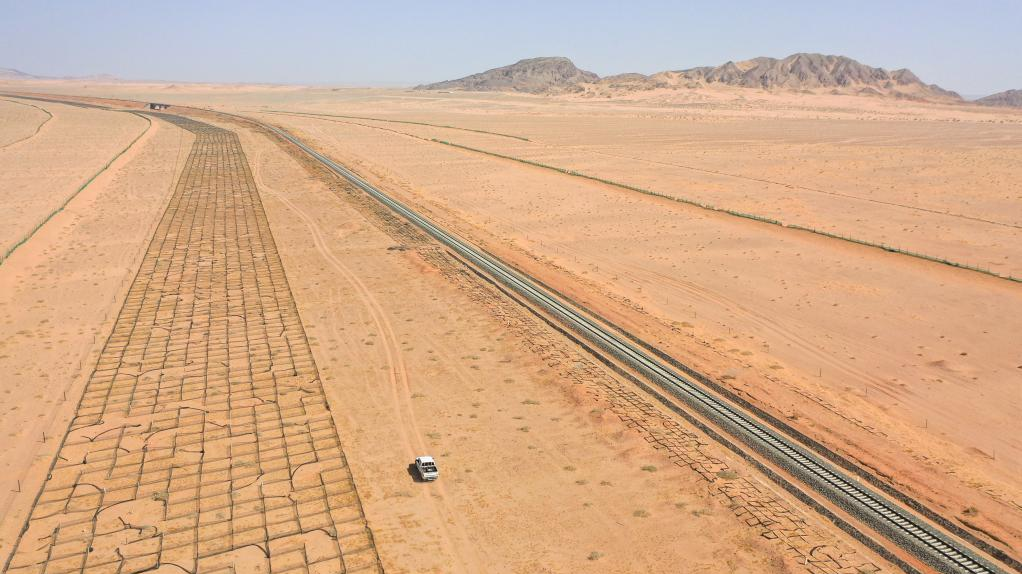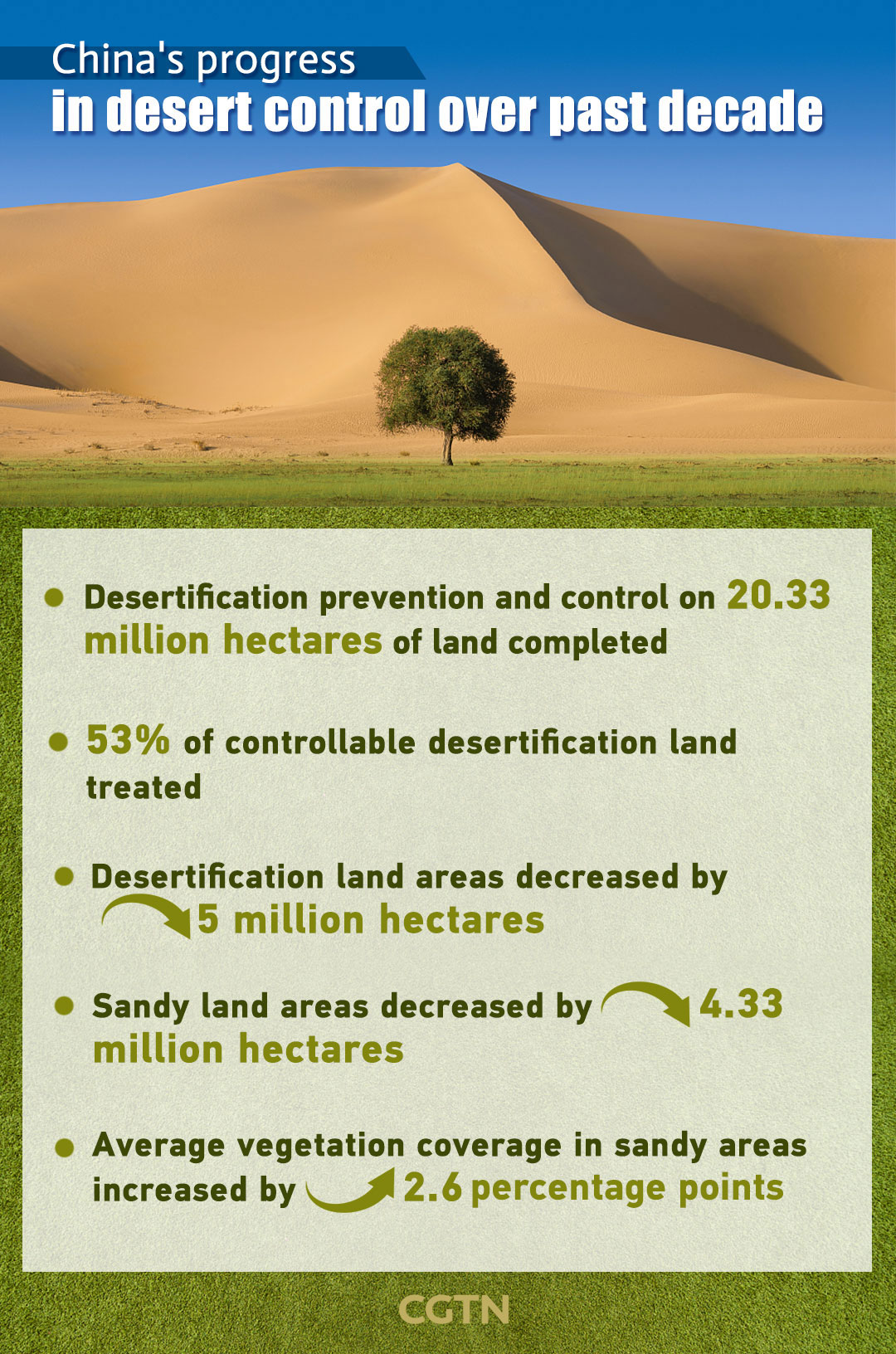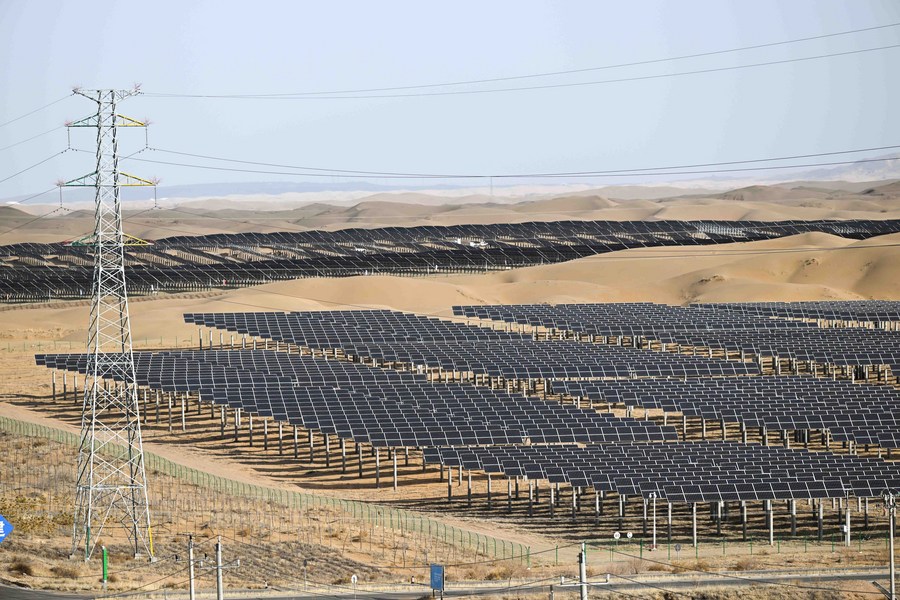
Workers in sand control stations making grids to contain the moving sand dunes along Linhe-Ceke railway in north China's Inner Mongolia Autonomous Region, April 14, 2021. /Xinhua
Workers in sand control stations making grids to contain the moving sand dunes along Linhe-Ceke railway in north China's Inner Mongolia Autonomous Region, April 14, 2021. /Xinhua
Yan Huaiping, 59, has been working as a sand control worker for more than 30 years along the Linhe–Ceke railway.
The railway stretches from the Linhe District in Bayannur, situated within north China's Inner Mongolia Autonomous Region, all the way to Ceke Port of Ejina Banner, running through desert regions with tough natural conditions.
In these regions, the annual rainfall is meager, measuring less than 50 millimeters. For approximately nine months of the year, strong winds with speeds frequently reaching level 8 or higher dominate the landscape. A big portion of the railway passes through uninhabited land, with over 65 percent of these areas experiencing sand damage.
"I remember that when this railway was first opened (in 2010), sand damage happened very frequently," said Yan.
Yan and his co-workers would often have to clear sand from the rails using shovels in strong winds. There were instances when they would remove the sand in the morning, only to repeat the same task in the afternoon to ensure the uninterrupted operations of the railway.
"After years of effort in sand control, occurrences of sand damage that disrupt railway operations have now become a rarity," he said.

Workers make grids to contain the moving sand dunes along Linhe-Ceke railway in north China's Inner Mongolia Autonomous Region, April 14, 2021. /Xinhua
Workers make grids to contain the moving sand dunes along Linhe-Ceke railway in north China's Inner Mongolia Autonomous Region, April 14, 2021. /Xinhua
Desert railway turns green
Over the past decade, two methods have been employed for sand control along the Linhe–Ceke railway. One is the biological sand control, which involves the planting of drought-resistant and sand-stabilizing vegetation in targeted areas.
This vegetation plays a crucial role in retaining moisture within the sandy terrain, thereby creating conducive conditions for the growth of localized "micro-ecosystems. To ensure the success of this method, a combination of watering and drip irrigation is employed, guaranteeing the survival and healthy development of these planted species.
Engineering sand control, on the other hand, entails the installation of sand-fixing grids and tall sand barriers in areas devoid of water resources. This method serves as a multi-layered defense mechanism against the infiltration of windblown sand onto the railway tracks.
Also, a network of twelve sand control stations has been set up along the railway. Sand control workers, including Yan, are stationed here year-round. They are responsible for the daily upkeep of the vegetation on both sides of the railway, as well as the maintenance of the sand-fixing grids.
Progress in past decade
Efforts to combat desertification along the Linhe–Ceke railway exemplify China's commitment to addressing this environmental challenge. Over the past ten years, 53 percent of the manageable desertification areas across China have undergone treatment.

The desert ecosystem in China is showing a trend of improved functionality and stability. In comparison to a decade ago, there has been a reduction of 5 million hectares in desertification areas and 4.33 million hectares in sandy lands.
Efforts in afforestation have also been ongoing, with the grassland vegetation coverage rate and national forest coverage rate increasing to 50.32 percent and 24.02 percent, respectively. After decades of afforestation, China has created the world's largest planted forests of 87.6 million hectares.
Over the past decade, China has implemented several ecological projects, including the Three North Shelterbelt Project aims at turning marginal farmland into forests and grasslands. The project is designed to protect natural forests and address the root causes of sandstorms.
Apart from the Three North Shelterbelt Project, China launched other 15 ecological projects like the Beijing-Tianjin sandstorm source control project, which combats desertification and dust hazards by increasing forested areas through the strategic planting of trees and grasses.

A photovoltaic power base in Dalad Banner, Erdos, north China's Inner Mongolia Autonomous Region, March 3, 2023. /Xinhua
A photovoltaic power base in Dalad Banner, Erdos, north China's Inner Mongolia Autonomous Region, March 3, 2023. /Xinhua
Economic benefits
China's seventh-largest desert Kubuqi in the Inner Mongolia Autonomous Region, was once an entirely barren landscape. Now it is covered by blue solar panels and green vegetations, thanks to the installation of a solar power station in the area.
The solar station generates power primarily to meet the electricity demands of a nearby industrial park, significantly reducing the reliance on electricity production from coal-fired power plants.
Beyond its contribution of green energy to the local community and industries, the solar power station helps in desertification control. As a result, the improved soil conditions and environment facilitate more diverse range of industries, including desert tourism and organic farming.
Local residents plant economic forests like Amorpha and Astragalus amidst the photovoltaic arrays. To enhance wind and sand control, they have introduced sand shrubs and grasses beneath the photovoltaic panels, effectively curbing sand movement.
Like the Kubuqi Desert, regions encompassing desertified and sandy lands across northwest, north, and northeast China have fostered sand industry to boosts the local residents' income.
As of 2022, there are more than 15,500 enterprises in the forestry, grassland and sand industry, according to the National Forestry and Grassland Administration. The sand sector's annual output value is estimated at about 500 billion yuan (about $94.6 billion).